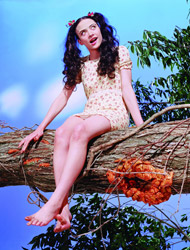Motohiko Odani

Motohiko Odani (born 1972, Japan)
Rompers, 2003
Single channel video, sound, 2 minutes, 52 seconds
Music by Pirami
Asia Society, New York: Promised Gift of Harold and Ruth Newman.
Motohiko Odani has been celebrated for his meticulously crafted objects and visions of utopia and dystopia since the late 1990s. A main theme underlying his sculpture, photography, and video work is mutation of humans and animals. In his celluloid-colored video Rompers, a computer-graphic-enhanced mutant girl sings, idyllically, while eerie insects crawl around her. She is indifferent to them and seems to accept that she is becoming something other than herself. The work comments on the mutation of nature in an age of bioengineering while appropriating the innocent setting of the children’s TV program, Romper Room that originally aired in the United States in the 1950s. On the Japanese version that was shown during the late 1960s and the 1970s, toy bees and cute animals frolicked with children.
Motohiko Odani was born in Kyoto, Japan, in 1972 and received an MFA from Tokyo University of the Arts in 1997. In his sculpture, photography, and video works, Odani mingles human, animal, and futuristic anatomy, exploring the boundaries of reality and myth, and the physical and the spiritual. Odani’s creations are eerie, yet visually stunning. He currently holds the position of Associate Professor in the Department of Intermedia Art at Tokyo University of the Arts. Odani’s works have been shown in various solo exhibitions, including “SP4 ‘The Spectator’ in Modern Sculpture,” Yamamoto Gendai Gallery, Tokyo (2009); and “En Melody,” Marella Arte Contemporanea, Milano (2001); as well as group exhibitions that include “MI VIDA: From Heaven to Hell,” MUeCSARNOK, Budapest (2009), and “Skin of/in Contemporary Art,” The National Museum of Art, Osaka (2007).
Select Bibliography
Uchida, Mayumi and Yayoi Kojima, eds. Neoteny Japan: Contemporary Artists After 1990s from Takahashi Collection. Tokyo: Bijutsu shuppan-sha, 2008.
Imafuku, Ryuta, Toshiharu Ito, and Makoto Sei Watanabe. Chikaku: Time and Memory in Japan. Köln: Verlag der Buchhandlung Walther Konig, 2005.
Kim, Yu Yeon, Cho Sun Rae, and Andrew Eom, eds. Translated Acts: Performance and Body Art from East Asia 1992–2001. Berlin: Haus der Kulturen der Welt; NewYork: Queens Museum of Art, 2001.


 Share
Share